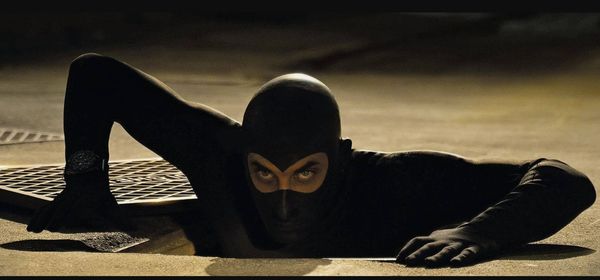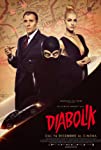Eye For Film >> Movies >> Diabolik (2021) Film Review
Diabolik
Reviewed by: Andrew Robertson

Diabolik is a thief. Not a cutpurse or a footpad though, not a highwayman or a lush-roller, not an embezzler, not a double-dipper, not any form of stick-up man. A criminal mastermind, a daredevil with a doctorate in disguise, skilled with a throwing knife and amoral enough to use it. It's that which makes Diabolik both potentially faithful to the comics character and also difficult to enjoy, even as an antihero.
The comics series has deep roots, created in 1962 by the Guiussani sisters. The genre of fumetti neri springs from his masked exploits. That's closer to 'funnies' than comics, but the neri is the same as cinema noir, if not darker. Italian film has a fair few fondnesses for colour, and there are moments of suspense here that feel more like the horror of giallo than the four-fold forces of truth, justice, Marvel and DC. That's even with the reflexive darkening of all things childish, a flight from silliness that means I have lived through countless gritty reboots of a very rich man whose unresolved childhood trauma compels him to dress up as a member of the order chiroptera to beat up criminals and slightly fewer but somehow grittier reboots of a refugee whose inculcation with American ideals leaves him as conflicted as any self-made colonial oppressor mired in myths of their own creation.

That said, what I was actually minded of was Dredd. That's at the tail of a series of borrowings, Carlos Ezquerra based old Stoney Face on Clint Eastwood's Man With No Name but also upon David Carradine's Frankenstein from Death Race 2000, and that glossy black mask owes a debt to Diabolik that no amount of silicone based polish could obfuscate. That there's another potential debt to Fantomas is neither here nor there. Though masks abound, reflecting light and alluded to by careful lighting, but at a level that borrows from another less callow super-spy series, the Mission: Impossible franchise. That callousness is what to me makes Dredd a high water mark of comics adaptation and Diabolik a problematic one. Dredd might have his name on the film, but he is our escort through a story that's about other characters. A key, if not a kicked door, through Mega City One. He's an object lesson, not a subject.
Diabolik is a protagonist, but not a likeable one. Not only an antihero, a murderer. Luca Marinelli has charisma in spades, but not here. Valerio Mastandrea as the unwavering Detective Ginko gets more character moments from lighting a pipe than anything else. Miriam Leone's (Lady) Eva Kant is glamour personified, though something about the set of her stance reminded me more of Kristen Stewart than any icon of La Dolce Vita. From the robbing of what might be the only bank that's open all night, we're shown Diabolik at his coolest. That cool becomes ice-cold in places, and that makes his relationships all the more important and harder to believe in, never mind keep track of. Rumbling through the streets of Clerville, an Italianate Gotham that's somewhere in a state that shares its name. Nuova York, Nuova York, and all that. We'll also see Bellair and Ghenf, and these fictional locations are portrayed by places like the Aosta Valley, Milan, Trieste.
Fictional locations that are populated by real brands. It's E-Type Jaguars that Diabolik favours, at one point I counted nine bottles of Campari on a bar and three Negronis served to the Lady Kant. That's including the one between the four shots of her BVLGARI watch-face, at one of the many moments where she's waiting. Waiting, as might we the audience, for something else to happen.
At 133 minutes it's packed and oddly paced. Its episodic feel seems to come from trying to compress decades of story into one lump, or at least weeks of serial story-telling. That the box office has done well enough that two sequels are already in post-production is perhaps neither here nor there when the film changes gears more regularly than any of its drivers. We're given the chance to watch that, in one of several moments of detail that might have impressed as a panel on the page but feel like frames wasted. I'd love to say that when the police say Diabolik has turned left even as we see him turning right, this was playing with the reliability of the narration, but much as with Joker this is a film that's very careful to flash back and confirm what was and has not been going on. That caution, though ,starts to feel less like certainty than like a lack of trust.
There's lots of quality here. The costuming is bang on, the locations are gorgeous. The wide array of secret doors and mimic-masks feel just the right flavour of unrealistic, counterweighted and compensated. The fondness for poured concrete from domino-effect staircases to circular car-parking features feels like it has been hewn from solid 1960s. That doesn't quite extend to the stunt-work though. One suspects that in the era they'd have been more cavalier with the vehicles. It seems the sound for some of the chases has been constructed after the fact, and with a heavy-hand, though that's also true of footsteps and otherwise. The score by Aldo Di Scazi and Pivio has a feel at times of John Barry. That's unfortunate when Dino De Laurentiis produced a filmed version in 1968 that was characterised by the introduction at the 2022 Italian Film Festival as a "second-rate James Bond". That 1968 version, written and directed by Mario Bava, is now a cult favourite, and Danger: Diabolik is (if you can find it) almost half an hour shorter than this.
What do the Manetti Bros do with those extra 28 minutes? Cram in enough that you start to wonder if they and all their co-writers needed more editors. They've done a lot of Crime TV, and also 2017's Love And Bullets, a mob musical and Song Of Napoli about an undercover policeman/pianist. Those were co-written with the late Michelangelo La Neve who collaborates here again. Rounding out the list is Mario Gomboli, who worked on a 2019 documentary about Diabolik with Giancarlo Soldi.
An adaptation of King Of Terror, a Diabolik story that's not only been reprinted but re-made. Comics continually devour themselves. Punisher might have started as a Spider-Man villain, but later outings borrow heavily from the Punisher: Max comics by Garth Ennis which don't feature the web-slinger at all. Iron Man 3 drew from the Warren Ellis Invincible Iron arc and it's those other takes on characters that gave them both variety and strength. In terms of comic book movies it wasn't just the presence of BVLGARI that reminded me of Frank Miller's take on Will Eisner's Spirit. Reverence can make tombstones of texts, take something from the page and still leave it flat.
This doesn't seem to build on new ground, indeed it seems to go back and forth over the same territory. The sudden introduction of split screens might be meant to indicate a tonal shift but instead feels like they got far enough into the film to unlock a new mode. There are some intriguing camera movements, there's a shot enabled by a drone from a hotel's frontage to a window but we don't go through it, indeed, the switch to the interior is more perverse than reverse. We get a glimpse of a rifled barrel of a microphone, but we're given later justification for misidentification.
I wasn't just counting Campari, but corpses. We're told that Diabolik leaves bodies in his wake but it left me in the audience cold. Luca Marinelli is being replaced in the sequels, and I don't know if those scripts will give another actor room to do something other than project a glassy confidence. Christian Bale's played emotionless criminals and murderers and masked vigilantes and Lee Marvin had a command of steel in eye and hand. Marinelli spends much of this film still, but even with a bit of Morse code there's not a dash of life to it.
Trying to make antihero antagonists bad enough to make them villainous in contrast produces absurdities like Martinis flavoured with children's tears. Diabolik goes some way with some of its antagonists, but a confrontation about the morality of taking lives between thief and thief-taker rings hollow. The contrast between the blade of the guillotine and the shining daggers of Diabolik is starker than lighting and geometry alone.
Geometry and arithmetic both feature. I am halfway convinced that one of the bank heists relies on a feat that's off by an order of magnitude. In one of the sequences a road is blocked with an improbable mechanism that makes the espresso machine in Live And Let Die look simple. The sum of it all is that if one had a fondness for the character, this might sate, but for most it won't add up.
Reviewed on: 29 May 2022If you like this, try:
The Adventures Of Tintin: The Secret Of The UnicornThe Italian Job
To Catch A Thief

















